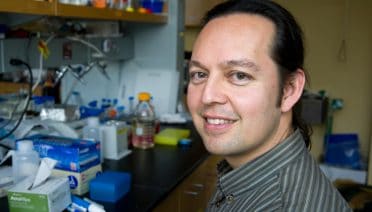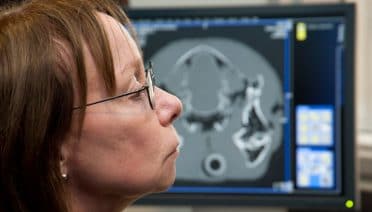Press Room
Two robots equipped with instruments designed to “listen” for the calls of baleen whales detected nine endangered North Atlantic right whales in the Gulf of Maine last month. The robots reported the detections to shore-based researchers within hours of hearing…
The Woods Hole Oceanographic Institution (WHOI) announces a new Center for Marine Robotics. The Center brings together academic, national security, and industrial partners with the goal of applying the full potential of computation and intelligence to bear to the ocean.…
There are more microbes in a bucket of seawater than there are people on Earth. Despite their abundance, humans are only just beginning to fathom the complex role marine microbes play in the ocean ecosystem. These tiny creatures are responsible…
Scientists from the newly created Northwest Atlantic Seal Research Consortium (NASRC) are using data collected by the Massachusetts Department of Public Health (MDPH) to investigate whether seals may impact beach water quality along Outer Cape Cod. A growing population of…
Mak Saito, a biogeochemist at Woods Hole Oceanographic Institution, has been selected for a Marine Microbiology Initiative (MMI) investigator award by the Gordon and Betty Moore Foundation. Saito is one of 16 scientists from 14 different institutions who will receive…
Darlene Ketten of the Woods Hole Oceanographic Institution has been named a Fellow of the American Association for the Advancement of Science (AAAS). Election as an AAAS Fellow is an honor bestowed upon AAAS members by their peers. A marine…
Engineers from the Woods Hole Oceanographic Institution (WHOI) have developed a new wireless underwater communication system to control remotely operated vehicles (ROVs) in real time. This new method may eliminate the need for long tether cables, offering a new degree…
People come from miles away to see the seals off the shores of Cape Cod and surrounding regions, but the animals are creating some challenges for local fishermen. Recent increases in local seal abundance have led to concerns about fisheries…
Japan’s “triple disaster,” as it has become known, began on March 11, 2011, and remains unprecedented in its scope and complexity. To understand the lingering effects and potential public health implications of that chain of events, scientists are turning to…
The ability of deep-sea corals to harbor a broad array of marine life, including commercially important fish species, make these habitat-forming organisms of immediate interest to conservationists, managers, and scientists. Understanding and protecting corals requires knowledge of the historical processes…
The Gulf Stream moved well north of its normal path in early November and mid-December of 2011, causing warmer-than-usual ocean temperatures along the New England continental shelf.
Secretary of the Navy Ray Mabus announced the nation’s newest research vessel will be named the R/V Neil Armstrong, after the renowned astronaut and the first man to set foot on the moon. The ship will be operated by the Woods Hole Oceanographic Institution (WHOI).
An international group of scientists, including researchers from the Woods Hole Oceanographic Institution, are working to improve communication about ocean acidification to help the public better understand the pressing global issue. The term “ocean acidification” (OA) describes the changes that…
WHOI President and Director Susan Avery and Director of Research Larry Madin were joined by National Institute of Standards and Technology (NIST) Deputy Director Willie May at a dedication ceremony Sept. 20 for the new Laboratory for Ocean Sensors and Observing Systems. The ceremonial ribbon cutting took place by the state-of-the-art facility’s high bay entrance, located on the Institution’s 160-acre Quissett campus.
WHOI received an $8.1 million grant from NIST in 2010 to fund construction of the new scientific research facility, as part of the American Recovery and Reinvestment Act. WHOI contributed $4 million to the project. The 27,000-square-foot, “green”-designed building will provide space for a major effort to create long-term ocean observatories.
A new partnership between oceanographers studying seafloor habitats, Web programmers and social scientists has resulted in a unique, interactive website called “Seafloor Explorer,” which asks members of the public to help identify objects they see in images of the seafloor. Seafloor Explorer (www.seafloorexplorer.org) launches September 13.
The team has more than 40 millions images, but are launching the site with a preliminary set of 100,000 – all of them taken by HabCam, a habitat mapping underwater vehicle. HabCam was developed and built by the HabCam group, which comprises marine biologists and engineers from the Woods Hole Oceanographic Institution (WHOI) as well as fishermen and other scientists.
A NASA-sponsored expedition is set to sail to the North Atlantic’s saltiest spot to get a detailed, 3-D picture of how salt content fluctuates in the ocean’s upper layers and how these variations are related to shifts in rainfall patterns around the planet.
When WHOI geologist Liviu Giosan first reconstructed the history of how the Danube River built its delta, he was presented with a puzzle. In the delta’s early stages of development, the river deposited its sediment within a protected bay. As…
Ocean scientists have long known that juvenile coral reef fishes use coastal seagrass and mangrove habitats as nurseries, later moving as adults onto coral reefs. But the fishes’ movements, and the connections between different tropical habitats, are much more complex…
Titanic is an iconic shipwreck that has fascinated the public for a century. But it also has a scientific and technological story to tell. On Saturday, Sept. 8, the Woods Hole Oceanographic Institution will host a public event entitled “Titanic…
new ocean research ship, AGOR 27, Ocean Class ship


